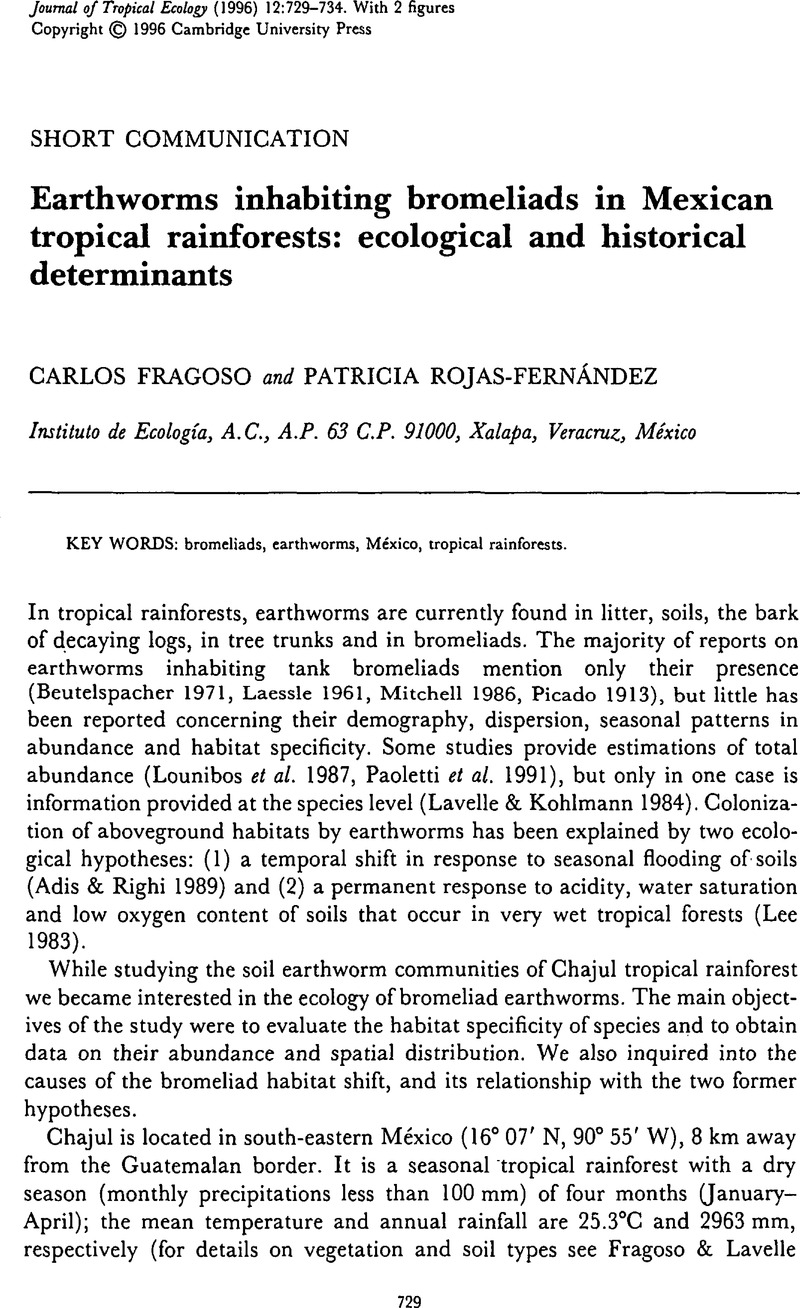Crossref Citations
This article has been cited by the following publications. This list is generated based on data provided by Crossref.
Bowman, D. M.J.S.
1998.
Tropical rain forests.
Progress in Physical Geography: Earth and Environment,
Vol. 22,
Issue. 4,
p.
545.
Rodgers, D. J.
and
Kitching, R. L.
1998.
Vertical stratification of rainforest collembolan (Collembola: Insecta) assemblages: description of ecological patterns and hypotheses concerning their generation.
Ecography,
Vol. 21,
Issue. 4,
p.
392.
Basset, Yves
2001.
Tropical Forest Canopies: Ecology and Management.
Vol. 69,
Issue. ,
p.
87.
Basset, Yves
2001.
Invertebrates in the canopy of tropical rain forests How much do we really know?.
Plant Ecology,
Vol. 153,
Issue. 1-2,
p.
87.
Ospina-Bautista, Fabiola
Estévez-Varón, Jaime V.
Betancur, Julio
and
Realpe-Rebolledo, Emilio
2004.
ESTRUCTURA Y COMPOSICIÓN DE LA COMUNIDAD DE MACRO INVERTEBRADOS ACUÁTICOS ASOCIADOS A TILLANDSIA TURNERI BAKER (BROMELIACEAE) EN UN BOSQUE ALTO ANDINO COLOMBIANO.
ACTA ZOOLÓGICA MEXICANA (N.S.),
Vol. 20,
Issue. 1,
p.
153.
Benzing, David H.
2004.
Forest Canopies.
p.
175.
Osses, Francini
Martins, Eduardo G.
and
Machado, Glauco
2008.
Oviposition site selection by the bromeliad-dweller harvestman Bourguyia hamata (Arachnida: Opiliones).
Journal of Ethology,
Vol. 26,
Issue. 2,
p.
233.
Ray, Julie M.
Montgomery, Chad E.
Mahon, Heidi K.
Savitzky, Alan H.
and
Lips, Karen R.
2012.
Goo-Eaters: Diets of the Neotropical Snakes Dipsas and Sibon in Central Panama.
Copeia,
Vol. 2012,
Issue. 2,
p.
197.
Elliott, Daniela Dutra
and
Ticktin, Tamara
2013.
Treetops at Risk.
p.
435.
Fragoso, Carlos
and
Rojas, Patricia
2014.
Biodiversidad de lombrices de tierra (Annelida: Oligochaeta: Crassiclitellata) en México.
Revista Mexicana de Biodiversidad,
Vol. 85,
Issue. ,
p.
197.
Decaëns, Thibaud
Porco, David
James, Samuel W.
Brown, George G.
Chassany, Vincent
Dubs, Florence
Dupont, Lise
Lapied, Emmanuel
Rougerie, Rodolphe
Rossi, Jean-Pierre
and
Roy, Virginie
2016.
DNA barcoding reveals diversity patterns of earthworm communities in remote tropical forests of French Guiana.
Soil Biology and Biochemistry,
Vol. 92,
Issue. ,
p.
171.
Aguilar-Cruz, Yonatan
García-Franco, José G.
and
Zotz, Gerhard
2020.
Microsites and early litter decomposition patterns in the soil and forest canopy at regional scale.
Biogeochemistry,
Vol. 151,
Issue. 1,
p.
15.
Maggia, Marie-Eugénie
Decaëns, Thibaud
Lapied, Emmanuel
Dupont, Lise
Roy, Virginie
Schimann, Heidy
Orivel, Jérôme
Murienne, Jérôme
Baraloto, Christopher
Cottenie, Karl
and
Steinke, Dirk
2021.
At each site its diversity: DNA barcoding reveals remarkable earthworm diversity in neotropical rainforests of French Guiana.
Applied Soil Ecology,
Vol. 164,
Issue. ,
p.
103932.
Dupont, Lise
Brunet, Carla-Marie
Fourcade, Yoan
James, Samuel
Gabriac, Quentin
and
Coulis, Mathieu
2023.
Recording earthworm diversity on the tropical island of Martinique using DNA barcoding unveiled endemic species in bromeliad plants.
Soil Biology and Biochemistry,
Vol. 182,
Issue. ,
p.
109038.
Ashwood, Frank
Lejoly, Justine
Keith, Aidan
and
Schmidt, Olaf
2024.
Earthworms and Ecological Processes.
p.
95.
Jorge, Jaqueiuto S.
Santos, Roberto Lima
de Sena Monte, Otávio
Freire, Eliza Maria X.
and
Caliman, Adriano
2024.
The Arrow Macambira (Encholirium spectabile: Bromeliaceae) as an Important Habitat for the Arthropod Fauna in Rocky Outcrops of the Brazilian Semi-Arid Region.
Neotropical Entomology,
Vol. 53,
Issue. 3,
p.
568.



